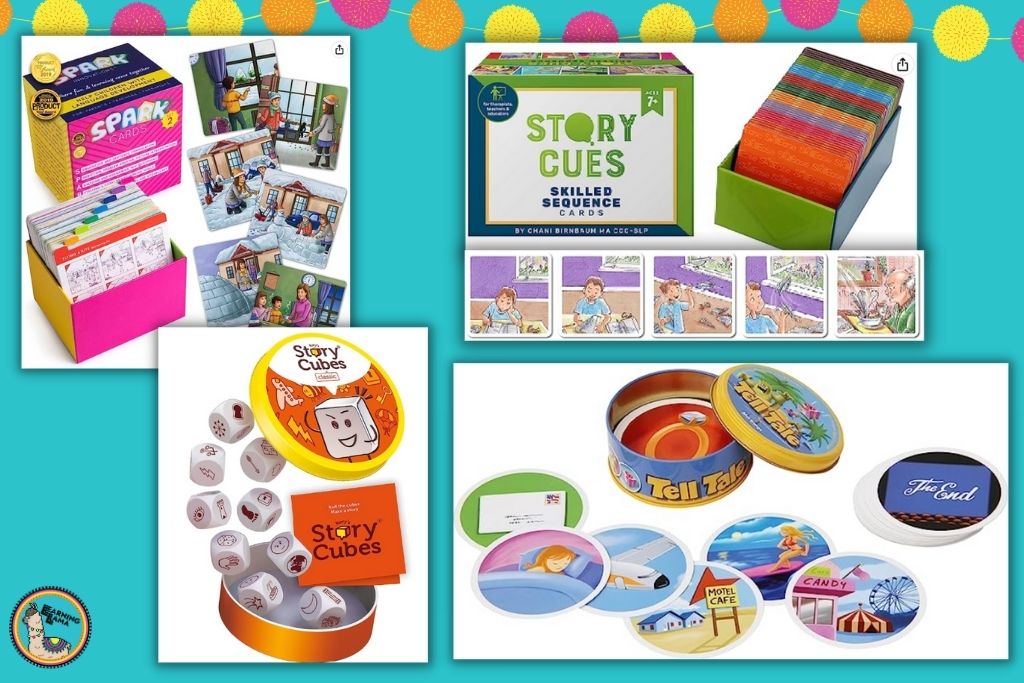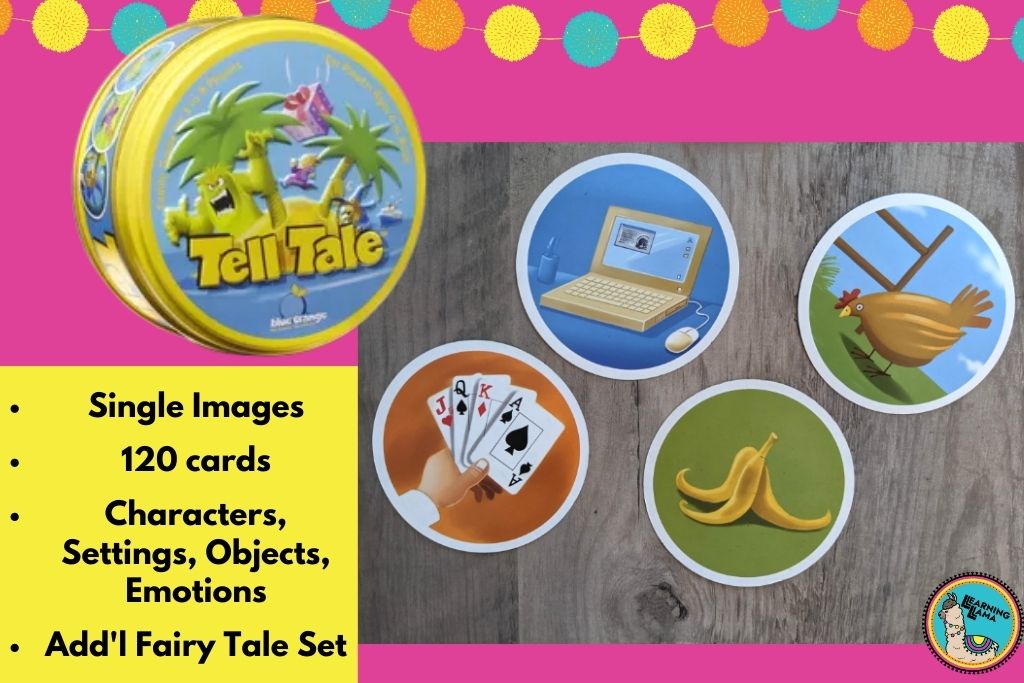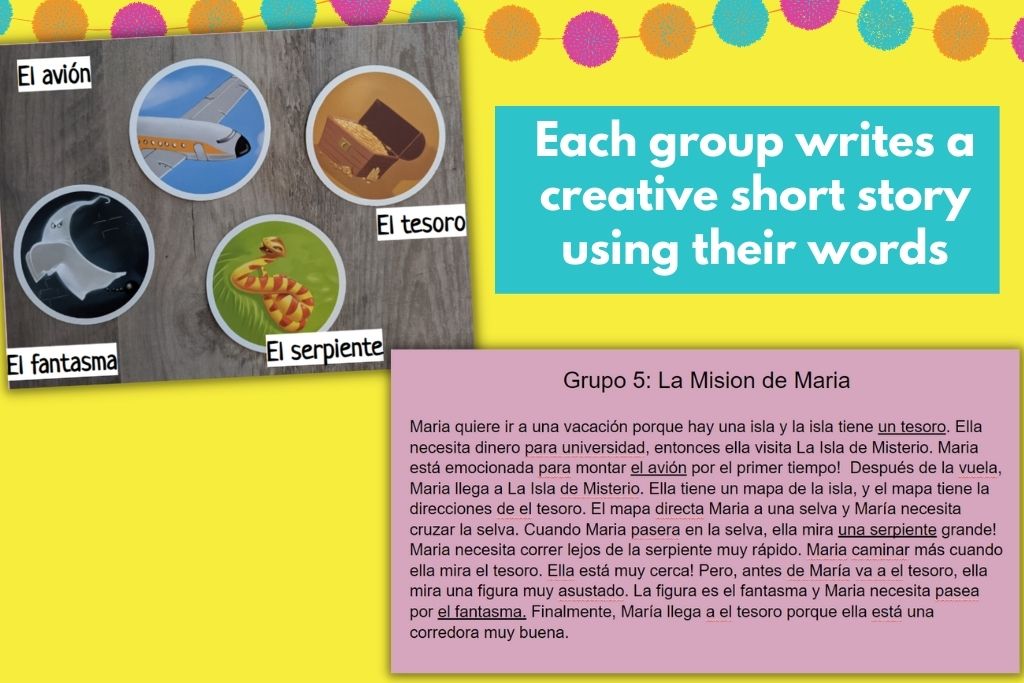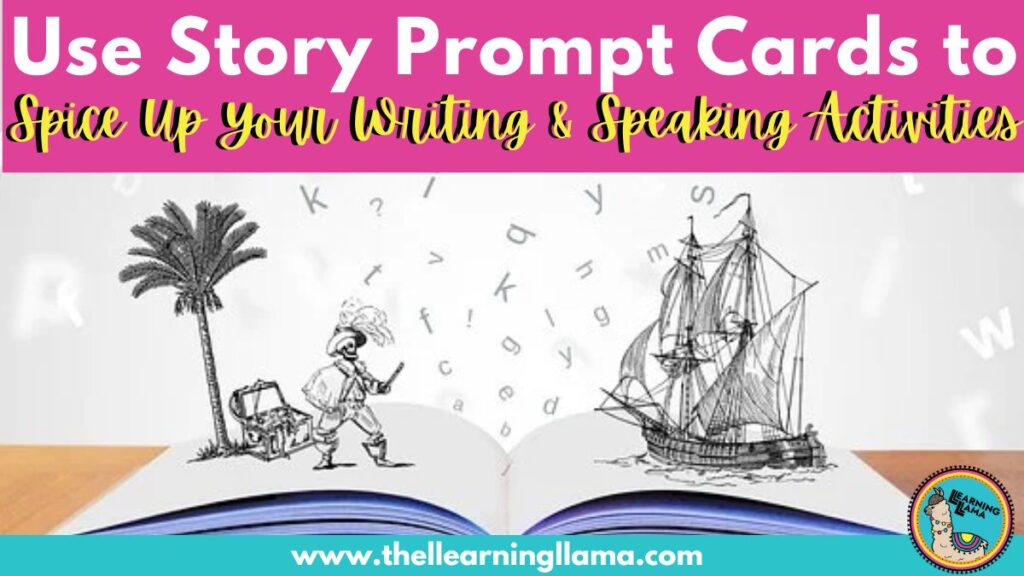Are you looking for a way to spice up your classroom communicative activities? Do students need more inspiration during creative writing tasks? Let me show you how story prompt cards can spice up your communicative tasks. With just one set of story prompt cards, you can have endless options for creative writing and speaking activities in the classroom!
Story Prompt Cards, specifically Tell Tale Cards have been a game changer in my classroom. I have seen my students’ creativity blossom; I have seen their vocabulary flourish. Keep reading to find out more about story prompt cards and to get tons of practical activities for speaking and writing tasks. These activities strengthen creativity, listening and language skills and promote literacy development.
Plus, these cards make for super easy emergency sub plans. Tell the sub that each student or group needs to write a story with a specific number of cards, number of sentences, etc. It is fun for them and doesn’t require any prep on your part!

What are Story Prompt Cards?
There are two types of story prompt cards that you can purchase.
Single Image Cards
The first are single image cards. Each story prompt card has just one image, so you could pass out one card or 5 cards and students need to incorporate all of the images into one story.
My favorite single image cards are Tell Tale cards. With these, students can invent stories with 120 illustrations of characters, settings, objects and emotions. There is also a Fairy Tale Tell Card set, perfect for when you are studying fairy tales, short stories, and legends. I have my students write their own fairy tale with this project. You could incorporate the tell tale cards to make the assignment even more exciting!
** TELL TALE CARDS have been unavailable on Amazon. But another great option is Curious Kingdom Story Starters! They give you a person, place, and thing!
Story Cubes are story prompt dice. Roll 9 cubes to generate 9 random images and then use these to invent a story that starts with “Once upon a time…” and uses all 9 elements as part of your narrative. You can choose to roll 1 to 9 dice, depending on your students!
Sequence Story Cards
The second style of cards are sequence story cards. Each “set” of cards comes with a sequence of 5 or 6 cards that tell a sequential story. For example, the first picture may be a girl putting on her pajamas. Picture number two is the girl brushing her teeth. The third picture is the girl getting into bed and so on.
Story Cues Sequence Cards – Included are 10 colored stories, 3.5 x 3.5 pictures with 5 cards per story for a total of 50 cards
Spark Cards – Included are 8 colored stories. 4.5 x 4.5 pictures with 6 cards per story for a total of 48 cards. There is also a Spark Jr. version with different images.

Before You Introduce the Cards
Make sure you prep students with the vocabulary needed to use these cards. Since Tell Tale cards come with such a random assortment of images, your students may not know how to say all of the words on the cards. For example, witch, toilet, and bridge are not words that come up often in second language acquisition. You can do one of four things for equipping your students with vocabulary needed to play with Tell Tale Cards.
- After each student gets their cards, walk around and verbally tell them any words they don’t know. This is time consuming and can end up in a chaotic mess. However if you have a small class of advanced students, they should know most of the words and it wouldn’t take long to circulate and provide the vocab.
- This takes a lot of time up front, but will save you time in the long run. Type out the vocabulary words in the target language (in a small font). Print out the words and tape them onto each individual card. If you have a Teacher Assistant, this is a perfect task to keep them busy!
- Along the lines of idea #2, you need to create a list of all of the vocabulary terms on the set of cards. But you can just create one long, alphabetized list. When you use the cards, pass out the list or display if for your class. They will use this mini dictionary to find the words on their cards.
- Just let students look them up! If you have classroom dictionaries this is the perfect time to use them. Or if you allow electronic devices, give students a two-minute limit to look up the words they need. Trust me, you don’t want them to have access to Google Translate as they write any stories.
Activities to Do With Story Prompt Cards
Tell Tale Cards can be used for group activities or individual assignments. Modify any of these activities for individual or group work.
Writing Activities
Creative Writing
Pass out 3-6 cards per group or student. Set a timer for 10 minutes and just let students write a creative story. The requirements: they must use all of the words on their cards in a unique way. If you are focused on a specific grammar concept or thematic unit, then require them to tie it into that as well.
Group Storytelling
Have students sit in a circle. Pass out 1 story prompt card to each student. Every student needs a blank piece of paper as well. They will all write one the first sentence to a story, using the vocabulary term on their card. For example, if you are given a card with a picture of a dog: “Había una vez un perro grande que se llamaba Paco” or “Hay un perro blanco y negro.”
Next, students will pass the paper to the student on their right. They will read the sentence that their classmate wrote and prepare to add a second sentence to that story. BUT, students will turn the Tell Tale card over and use a new vocabulary word. If you want them to use the same word over and over, they can, but they could get bored doing that. Keep passing the paper and pulling a new card out of the tin until they write 10 sentences! At the end, return the paper to the original owner and read a funny story!
Gallery Walk Stories
Set up different stations around the classroom, each with a handful of cards and a blank piece of paper (or large white board). Students will each start at one station. They will choose a card and begin the story. Once they use a card, they should turn it into you so it is not used again. After a few minutes, have them rotate to another station where they will use the remaining cards to continue the story. After each student has rotated to all stations, then the story should be complete!
Stations/Choice Boards
Depending on what you are currently teaching in the classroom, you can use Tell Tale Cards to supplement your teaching. For example, if you are teaching the past tense, you could use the cards to set up these sample stations or choice board options: 1. Use 5 cards to write a story in the past tense. 2. Choose any 10 cards and write ten complete sentences in the past (doesn’t need to be a story). 3. Act out a story/play with your group. Use five cards to incorporate into your play. 4. Draw a picture using the images from five cards. Then narrate a story in the past tense. Learn more about creating choice boards here.
Comic Book Stories
With the sequence style story prompt cards like these or these, students can put the images in logical order. Since each set comes with about 5 or 6 cards, showing people doing different activities, students can provide the dialogue in comic book style format for the story. They can use dry erase markers to write on the cards or even add post-it notes!
Story Elements
Go back to the basics. Teach your world language students how to write a story… something they probably learned in English class. Focus on words like plot, characters, theme, setting, climax, etc. Help students write a detailed story with transition words and conjunctions. After they write their story, have them identify the different elements of the story.

Speaking Activities
Taboo
If you have never played Taboo, it is very simple. You try to get your teammate to guess the word you are describing without saying the word (and other related words). In this case of this game, students are not permitted to say the word on the card. This is a great exercise to practice circumlocution. Josh Cabral has some handy phrases to teach students when practicing circumlocution here. For example: the word is beach. Es un lugar donde tomas una vacación. Hay arena y el océano. (It is a place where you take a vacation. There is sand and ocean.)
Password
Two teams of two play against each other. Try to get your teammate to guess the word on the story prompt card by saying one word at a time. This is for more advanced students. For example: the word is ambulance. Team A could say “vehículo.” Then, Team A would guess “carro.” Team B would say “hospital.” Team B would guess “ambulancia.” If the second team was not correct, Team A would try again.
Speed Dating
Tell a creative story, but instead of writing it down, verbally tell a story. Have students form two lines, where they are sitting across from another student. Pass out one card to each pair. They will begin telling a story using that vocabulary term. After 15-20 seconds, signal to students to pass the card to the next pair. (The group on the end should give their card to the first group). Keep up this exercise until students have seen all the cards. By the end, they should have a fun story. All groups should have seen the same cards, so it will be interesting to hear how similar or different their stories are.
Tell a Story
Use the sequencing cards to simply talk in small groups. Describe what is happening in each image with as much detail as possible. You can even set a timer before students can move onto the next image.
Pitfalls of Story Prompt Cards
You want to avoid the sneaky students who will inevitably use the cards to tell a story like this: “Once upon a time there was an alien. He saw a boat. Then he saw a treasure chest. Then he got a letter. He had a cat named Fluffy. The end!”
To do this, you might want to set requirements or just show them the example above (in the target language). Then, give a detailed, strong example. Talk about the differences and explain what you are looking for.
With the sequence cards, once they’ve used one set, they probably won’t want to do that story again. So if a set comes with 10 stories, you want to make sure that each time you use the cards, students get a different story.
This post may have affiliate links. If you make a purchase from these links, I may receive a small commission. Thank you for supporting me, a fellow educator!





